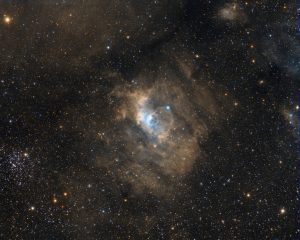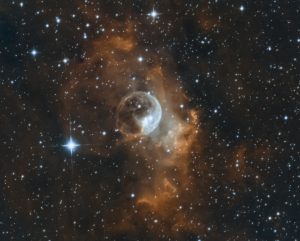The Bubble Nebula (NGC 7635, Sharpless 162, or Caldwell 11) is a bubble of interstellar atomic hydrogen (HII region) ionized by the strong ultraviolet radiation on the O-type hot star (BD+60°2522) that is within the nebula, but not in the center of the bubble: it is shown in the lower-right of the sphere, in the image 2 of this post. This asymmetry makes the star appear dramatically off-center from the bubble. According to NASA, as the surface of the bubble’s shell expands outward, it slams into dense regions of cold gas on one side of the bubble and off-center. The star is 44 times more massive than the Sun, it is very bright, and with a short time to live in the main sequence: in 10 – 20 million years, it will become a supernova. NGC 7635 is from 7 to 10 light years across and is some 7,100 – 11,000 light years away from us located in the constellation of Cassiopeia.
According to scientific research, the bubble, being a shell of interstellar gas (and very little dust) consisting of three different condensations that gives it a comet-like look, is not a Planetary Nebula (such as for example the Helix Nebula) or a supernova remnant (such as for example the Crab Nebula).
The most interesting aspect of this nebula is exactly its very simple and thus a very symmetric geometric shape of a sphere. The radiation from the star heats up the hydrogen (to up the electron temperature of 15,000 K) creating its awesome glow. The Hubble image of NGC 7635, was chosen to mark the 26th anniversary of the launch of Hubble Space Telescope in 1990.
Image 1
Data and processing: Goran Petrov
License: Creative Commons BY NC (free for non-commercial use, with attribution).
Click on the image to view in full size.
Location: Berovo, Macedonia
Date: 2018-08-12
Total integration time: 6 hours
Camera: ATIK One 9.0, cooled to -20C
Telescope: Takahashi FSQ 106 ED refractor
Filters:
Ha, SII, OIII: total of 24 x 15 min
Processed in PixInsight.
This photograph was made with the use of narrowband filters.
Narrowband Information was mapped to RGB (with a modified Hubble Palette).
Luminance information was synthetized from narrowband.
Image 2
Data and processing: Goran Petrov
License: Creative Commons BY NC (free for non-commercial use, with attribution).
Click on the image to view in full size.
Location: Mala Matka, Sopište, Macedonia
Date: 2016-09-14
Total integration time: 6 hours
Camera: ATIK One 9.0, cooled to -20C
Telescope: TS-Optics 10″ Ritchey-Chrétien Pro RC Telescope 254/2000 mm OTA
Filters:
Ha, SII, OIII: total of 23 x 15 min
Processed in PixInsight.
This photograph was made with the use of narrowband filters.
Narrowband Information was mapped to RGB (with a modified Hubble Palette).
Luminance information was synthetized from narrowband.

